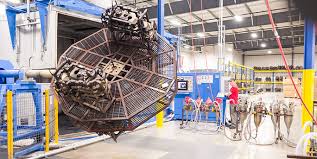Plastics rotomolding, also known by the name of rotational mold, is a versatile and economical manufacturing process that is that produces hollow plastic components. This method has become more and more popular due its capability to produce complex shapes, sturdy products and its suitability for both big and small-scale production runs. Here’s a comprehensive look at what you need to know about plastics Rotomolding.
The Process:
Rotational Molding involves heating a plastic material, usually in the form of powder or granules inside an empty mold. The mold is then turned around multiple axes. This allows the plastic to uniformly coat the inside of the mold. As the mold cools, the plastic expands, creating a hollow part that has an uniform wall thickness. The process usually involves several important steps: heating, rotating in the cooling process, heating, and demolding.
Materials Used:
The most common materials used for rotomolding include polyethylene (PE), polypropylene (PP), and nylon. Polyethylene is favored for its low price and high impact resistance, making it perfect for applications such as tanks containers, tanks, and playground equipment. Polypropylene offers better chemical resistance and is commonly used to make automotive parts and industrial containers. Nylon is used for parts which require strong strength and durability, such as structural and mechanical components, such as gears and structures.
Advantages:
Flexible Design: Rotomolding allows for the creation of complex shapes as well as massive, seamless components with no need for seams or joints. Design flexibility makes it perfect for producing custom complex designs.
Durability: The process produces pieces with uniform wall thickness and constant mechanical properties. The result is products that are strong and durable. They also stand up to environmental stress and impact.
Cost-Effective: Rotomolding is generally more economical than other methods of manufacturing, especially for medium to large-sized parts. The process requires relatively low tooling costs compared to techniques like blow molding or injection molding.
Low Waste: The process is highly efficient when it comes to the use of material, as excess material can be reused. This makes rotomolding an environmentally sustainable option when compared to other manufacturing techniques that produce more waste.
Applications:
Rotomolding is employed in a wide range of industries. In the automotive industry it is used to make parts like fuel tanks and bumpers. In the sector of consumer goods it’s used to make items such as coolers, storage containers or playground items. It’s also popular in the industrial field for making tanks, bins, as well as agricultural machinery.
Limitations:
Despite its advantages Rotomolding is not without its drawbacks. It isn’t the best method for producing very tiny or intricate parts because of its slow production process. Additionally, it can be difficult to produce extremely precise tolerances or intricate finish on surfaces when compared with other techniques.
In short, plastics rotomolding is a valuable manufacturing process that provides flexibility, durability, and cost-effectiveness. Its capacity to make large hollow pieces with uniform wall thickness makes it a preferred option for a variety of industries.

